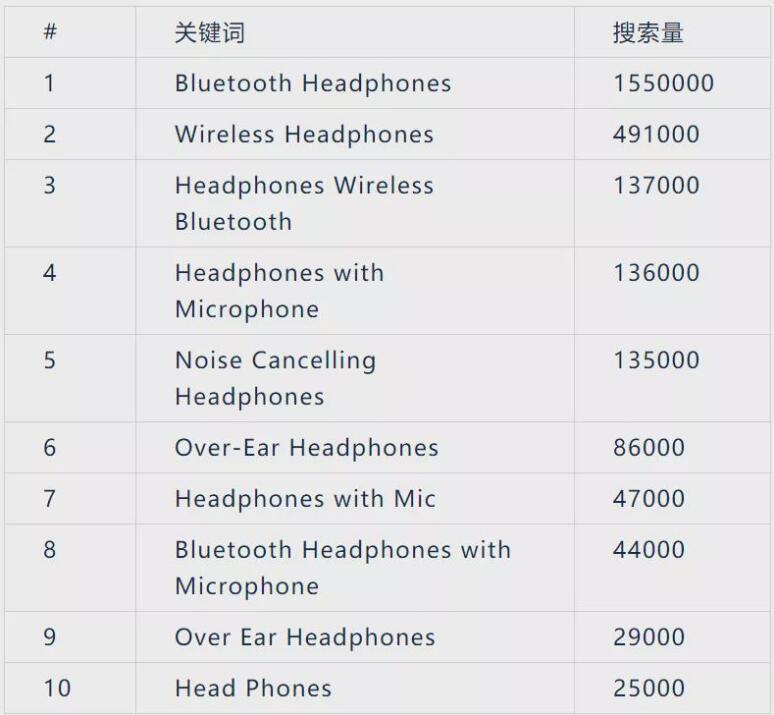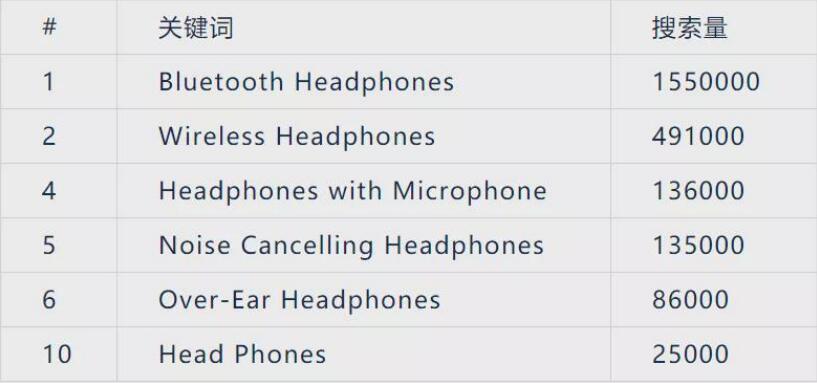How to optimize everyone’s Amazon listing to better attract target shoppers and improve rankings and achieve a consistent style throughout the store. Therefore, the editor has compiled the following knowledge points for you:
1. Use your keyword research
The basis for the success of any product advertising is based on a strong set of keyword research that serves the product. It doesn't matter whether you've done it before. If you plan to run ads on Amazon PPC, you will need a new set of keyword data. We can use this data in listing.
As mentioned earlier, Amazon has stated that they will analyze our keyword list. Therefore, we need to make every keyword mentioned 100% related to our own products and markets. If some unrelated keywords are included, they will be ranked naturally.
For example, the "headphones" mentioned when selling headphones. It's OK to mention it once, but repeating it will only provide rankings for your headphone list. If someone searches, it will be converted.
Once you have a set of keyword data, you need to break it down from the highest search volume to the lowest search volume. First, you need to select about 10 main keywords with different search volumes.
This set of keywords is strictly applicable to wireless headsets (with noise reduction and microphone):

Some common keywords excluded from this list include: earphones, headset, wired, and branded keywords.
There are many other low search volume keywords that you can find elsewhere, but this main collection is important for your Amazon titles and points.
(1) Add keywords to the title
Amazon’s title is the most important factor in your natural ranking because it holds the most weight in your product category. It needs to include the most searched keywords, but it also needs to be short enough to cater to mobile users.
Based on the data set provided above, the ideal title is as follows:
<Brand Name> Bluetooth Headphones - Wireless Headphones with Microphone - Over Ear, Noise Cancelling Headphones - <Color>
This will select the keywords with the most search volume and also mention the product features.
(2) Add keywords to the five-point description
This becomes a little difficult when we want to add these keywords to our five-point description, because we want to avoid reusing these keywords so that we don’t feel like we’re “keyword filler.” Instead, we can group some keywords together (they mention the same functionality) and select the one with the highest search volume:

These 6 keywords refer to all key features and keyword changes and can be inserted into the five-point description, which is much easier than trying to mention or repeat 10 keywords. You should also insert some long-tail keywords from the keyword research list, but only mention them once.
For the above 6 keywords, try to repeat the word with the highest search volume at least twice. Combine this with the long-tail keyword (repeat only once), and finally, we will have a five-point description that is highly optimized for selling wireless headphones.
2. How to write five descriptions?
It's one thing to know which keywords to include, but you need to include them in a logical way in the listing to help shoppers easily find information about your product.
When shoppers visit your product page, they want to confirm whether this is the product they want to buy. That is, whether it has a specific function to meet their specific expectations, whether it is price or social proof.
Therefore, when writing these 5 key points, it is important to consider the type of information shoppers may want to know. This is easy to do, we can focus on the functionality of the product, taking the following format as an example:
●BLUETOOTH HEADPHONES-Insert about two sentences to discuss this function
●NOISE CANCELLING HEADPHONES-Insert about two sentences to discuss this function
●HEADPHONES WITH MICROPHONE-Insert about two sentences to discuss this function
●SMARTPHONE COMPATIBLE-Insert about two sentences to discuss this function
●COMFORTABLE OVER-EAR HEADPHONES-Insert about two sentences to discuss this function
By using the best keywords in our list as part of the capital word characteristics, we have repeated the keywords once. Although the keywords with the highest search volume can be repeated more than once, try to include long-tail keywords, do not include keywords that are not related to the product, and keep keywords highly targeted for product and keyword research.
As part of the optimization listing, we should remember that while writing the key points in length is a great way to include a lot of keywords, it can also distract shoppers. If your text is more than 3 lines, consider shortening your key points to make it simpler.
It is necessary to proofread the copy before publishing keywords. There are many tools online, or service providers can provide low-cost services. This helps prevent misleading content from being published and improves overall awareness of your brand.
Finally, take this style of listing and map it into your product range. This creates a consistency that makes consumers feel that they are buying a reputable brand. All your products look similar, which can increase consumer confidence if they like your product and want to explore other products you have.
3. Description and backend keywords
Finally, we need to optimize our own description and backend keywords. The weight of the description is minimal when it comes to improving your organic search performance. If you choose A+ content, this is also correct. This is really just another opportunity to discuss your product in more detail and help you facilitate sales. If you can use A+, you can use a lot of pictures to discuss product features.
If limited to traditional descriptions, make sure to use formats to make the description more attractive. Focus on including more long-tail keywords than short-tail keywords, as we have used the main keywords heavily in the title and five-point description.
Backend keywords are our last chance to tell Amazon what keywords we want our products to relate to. The keywords included here are not as influential as front-end keywords (titles, etc.), but they are still influential.
We need to list less than 250 characters outside the main keyword to describe the product. Still have to be as relevant as possible. For example, "Earphones" is not worth including, but consider using "Headest".
One way to find these keywords is to refer to your keyword research and look at keywords with search volumes ranging from 50 to 500. Any keywords that are directly related to our products are valuable here and we can display keywords in any order. Avoid any keywords that are already included in your front end.
Complete backend keyword research can take a lot of time, but by following these common rules, you can create a collection that suits your products and help Amazon better categorize listings.
4. Summary
Properly optimizing listings can help Amazon correctly understand and interpret your listings. Amazon can only "read" your listing, understand by interpreting keywords and analyzing how Amazon shoppers use it. A well-optimized listing will not only help listings to rank naturally, but will also improve PPC advertising performance, because Amazon can determine which keywords your listing is suitable for bidding.
The success of PPC will speed up sales, and in turn will speed up your natural ranking. If we don't consider our listing with such attention, it will only hurt our natural rankings and the performance of paid advertising.
